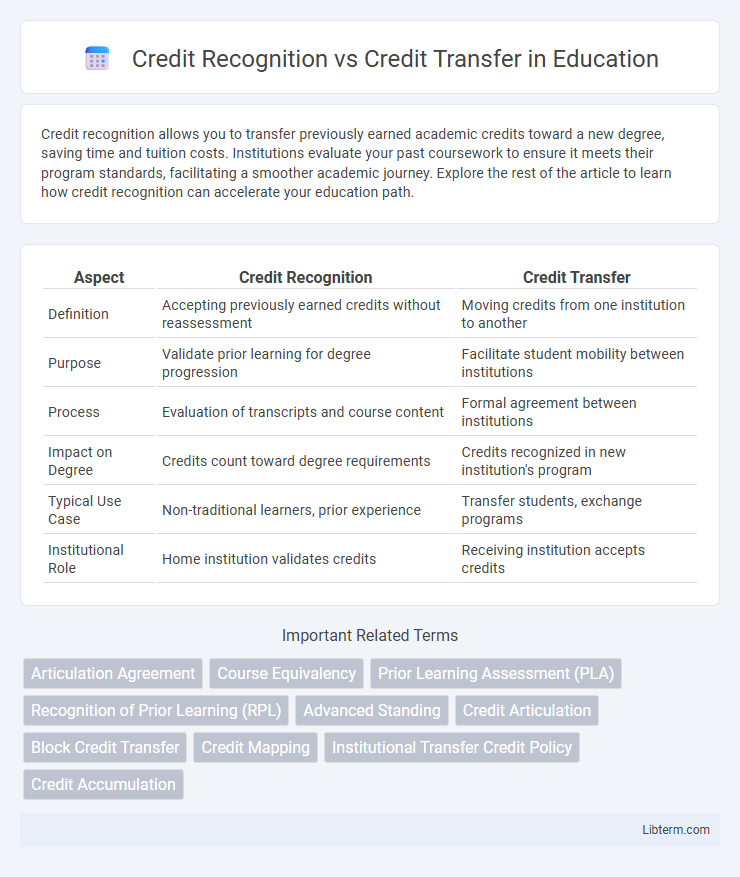Credit recognition allows you to transfer previously earned academic credits toward a new degree, saving time and tuition costs. Institutions evaluate your past coursework to ensure it meets their program standards, facilitating a smoother academic journey. Explore the rest of the article to learn how credit recognition can accelerate your education path.
Table of Comparison
| Aspect | Credit Recognition | Credit Transfer |
|---|---|---|
| Definition | Accepting previously earned credits without reassessment | Moving credits from one institution to another |
| Purpose | Validate prior learning for degree progression | Facilitate student mobility between institutions |
| Process | Evaluation of transcripts and course content | Formal agreement between institutions |
| Impact on Degree | Credits count toward degree requirements | Credits recognized in new institution's program |
| Typical Use Case | Non-traditional learners, prior experience | Transfer students, exchange programs |
| Institutional Role | Home institution validates credits | Receiving institution accepts credits |
Understanding Credit Recognition and Credit Transfer
Credit Recognition involves acknowledging previously earned academic credits from one institution without altering a student's current academic record, allowing them to fulfill degree requirements based on prior learning. Credit Transfer refers to the process where academic credits earned at one institution are formally accepted and applied towards a student's program at another institution, often requiring evaluation for equivalency. Understanding the distinctions between Credit Recognition and Credit Transfer is essential for students to effectively navigate credit mobility and optimize their educational pathways.
Key Differences Between Credit Recognition and Credit Transfer
Credit recognition involves acknowledging and accepting previously earned academic credits towards a new program without altering their original status, whereas credit transfer entails moving credits from one institution to another, often requiring evaluation and conversion. Key differences include the scope of application, where credit recognition typically applies within the same institution or system, and credit transfer occurs between different institutions. Evaluation criteria also differ, with credit transfer demanding alignment with new curriculum requirements, while credit recognition usually respects prior course equivalency as granted.
Importance in Academic Progression
Credit recognition and credit transfer play crucial roles in academic progression by validating prior learning and enabling seamless continuation of education. Credit recognition acknowledges competencies gained through formal or informal experiences, ensuring students do not repeat previously mastered content. Credit transfer facilitates the movement between institutions or programs, accelerating degree completion and reducing redundancy in coursework.
Criteria for Credit Recognition
Criteria for Credit Recognition primarily include the alignment of course content, learning outcomes, and academic level between previously completed courses and the new curriculum. Institutions assess the accreditation status of the prior institution, the grading system, and the student's performance to ensure equivalency and academic rigor. Documentation such as detailed syllabi, transcripts, and official course descriptions supports the verification process in credit recognition.
Requirements for Credit Transfer
Credit transfer requires official documentation such as transcripts, course descriptions, and syllabi to verify the content and level of completed coursework for equivalency evaluation. Institutions typically mandate a minimum grade threshold, commonly a C or higher, to accept credits for transfer to ensure academic standards are maintained. Formal approval from academic advisors or registrar offices is essential to confirm that the transferred credits align with the program's curriculum requirements.
Benefits of Credit Recognition
Credit recognition allows students to receive formal acknowledgment for prior learning achievements, reducing the time and cost required to complete a qualification. This process helps institutions efficiently validate existing competencies, enhancing student motivation and supporting academic progression without redundant coursework. Recognizing credits promotes seamless educational pathways, increasing retention rates and accelerating entry into the workforce.
Advantages of Credit Transfer
Credit transfer allows students to move completed course credits from one accredited institution to another, facilitating academic progression without repeating coursework. This flexibility reduces time and financial costs for learners while ensuring that prior learning is acknowledged and applied toward degree requirements. Institutions benefit from credit transfers by promoting student mobility and enabling diverse educational experiences across programs.
Common Challenges and Solutions
Credit recognition and credit transfer processes often face challenges such as inconsistent evaluation criteria, lack of standardized documentation, and limited transparency between institutions. These issues can be addressed by implementing unified credit frameworks, adopting comprehensive digital platforms for record sharing, and establishing clear communication channels to ensure accurate credit equivalency assessments. Enhancing collaboration between academic institutions and leveraging technology-driven solutions improve efficiency and student mobility in credit recognition and transfer systems.
Impact on Graduation Timeline
Credit recognition allows students to acknowledge previously earned credits, potentially reducing redundant coursework and accelerating program completion. Credit transfer involves the formal acceptance of credits from one institution to another, which can significantly shorten the time required to meet graduation requirements. Efficient management of both processes can streamline academic progress, minimizing delays and ensuring timely graduation.
Best Practices for Students
Students should maintain detailed academic records and official course descriptions to facilitate the credit recognition process, ensuring that previously earned credits align with degree requirements at the new institution. Engaging early with academic advisors helps clarify eligibility for credit transfer and reduces the risk of losing credits during transition between programs or universities. Utilizing established articulation agreements and staying informed about institutional policies maximizes credit transfer efficiency and supports seamless academic progression.
Credit Recognition Infographic

 libterm.com
libterm.com